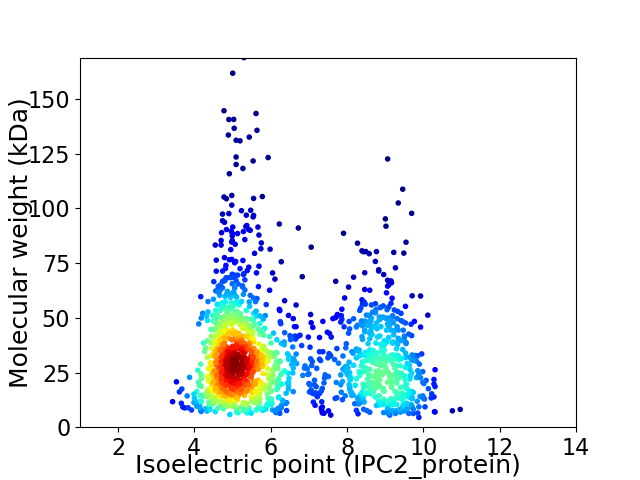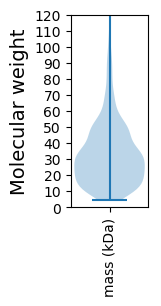
Lactobacillus equigenerosi DSM 18793 = JCM 14505
Taxonomy: cellular organisms; Bacteria; Terrabacteria group; Firmicutes; Bacilli; Lactobacillales; Lactobacillaceae; Limosilactobacillus; Limosilactobacillus equigenerosi
Average proteome isoelectric point is 6.41
Get precalculated fractions of proteins

Virtual 2D-PAGE plot for 1490 proteins (isoelectric point calculated using IPC2_protein)
Get csv file with sequences according to given criteria:
* You can choose from 21 different methods for calculating isoelectric point
Summary statistics related to proteome-wise predictions



Protein with the lowest isoelectric point:
>tr|A0A0R1UH54|A0A0R1UH54_9LACO N-acetyltransferase domain-containing protein OS=Lactobacillus equigenerosi DSM 18793 = JCM 14505 OX=1423742 GN=FC21_GL000215 PE=4 SV=1
MM1 pKa = 7.48LSIGSIVYY9 pKa = 10.61LEE11 pKa = 4.99GGDD14 pKa = 3.65QKK16 pKa = 11.82LMIIGQGQIMEE27 pKa = 4.21QNKK30 pKa = 7.43QQVYY34 pKa = 9.44FDD36 pKa = 4.37YY37 pKa = 11.0VACQYY42 pKa = 10.95PSGIDD47 pKa = 3.53PEE49 pKa = 4.22EE50 pKa = 3.67VYY52 pKa = 10.97YY53 pKa = 10.66FNKK56 pKa = 10.14EE57 pKa = 3.97DD58 pKa = 3.36IAEE61 pKa = 4.31VVFDD65 pKa = 4.33GYY67 pKa = 11.05RR68 pKa = 11.84DD69 pKa = 3.64EE70 pKa = 5.22EE71 pKa = 4.71SYY73 pKa = 11.24KK74 pKa = 10.25VDD76 pKa = 3.14QLYY79 pKa = 9.91QEE81 pKa = 4.77WIEE84 pKa = 4.22KK85 pKa = 9.53TDD87 pKa = 3.72LPKK90 pKa = 11.23GEE92 pKa = 4.29TSLL95 pKa = 4.47
MM1 pKa = 7.48LSIGSIVYY9 pKa = 10.61LEE11 pKa = 4.99GGDD14 pKa = 3.65QKK16 pKa = 11.82LMIIGQGQIMEE27 pKa = 4.21QNKK30 pKa = 7.43QQVYY34 pKa = 9.44FDD36 pKa = 4.37YY37 pKa = 11.0VACQYY42 pKa = 10.95PSGIDD47 pKa = 3.53PEE49 pKa = 4.22EE50 pKa = 3.67VYY52 pKa = 10.97YY53 pKa = 10.66FNKK56 pKa = 10.14EE57 pKa = 3.97DD58 pKa = 3.36IAEE61 pKa = 4.31VVFDD65 pKa = 4.33GYY67 pKa = 11.05RR68 pKa = 11.84DD69 pKa = 3.64EE70 pKa = 5.22EE71 pKa = 4.71SYY73 pKa = 11.24KK74 pKa = 10.25VDD76 pKa = 3.14QLYY79 pKa = 9.91QEE81 pKa = 4.77WIEE84 pKa = 4.22KK85 pKa = 9.53TDD87 pKa = 3.72LPKK90 pKa = 11.23GEE92 pKa = 4.29TSLL95 pKa = 4.47
Molecular weight: 11.06 kDa
Isoelectric point according different methods:
Protein with the highest isoelectric point:
>tr|A0A0R1UN19|A0A0R1UN19_9LACO HAD superfamily (Subfamily IIIA) phosphatase OS=Lactobacillus equigenerosi DSM 18793 = JCM 14505 OX=1423742 GN=FC21_GL000376 PE=4 SV=1
MM1 pKa = 7.1NQQLHH6 pKa = 6.04PQAKK10 pKa = 8.75VQQHH14 pKa = 5.5PQANQQLRR22 pKa = 11.84QQAKK26 pKa = 6.94VQRR29 pKa = 11.84HH30 pKa = 4.7PQVNQQLRR38 pKa = 11.84LRR40 pKa = 11.84AKK42 pKa = 9.89AQRR45 pKa = 11.84HH46 pKa = 4.66PQVNQQLHH54 pKa = 4.5QQAKK58 pKa = 8.04VQLRR62 pKa = 11.84QQVNQLL68 pKa = 3.23
MM1 pKa = 7.1NQQLHH6 pKa = 6.04PQAKK10 pKa = 8.75VQQHH14 pKa = 5.5PQANQQLRR22 pKa = 11.84QQAKK26 pKa = 6.94VQRR29 pKa = 11.84HH30 pKa = 4.7PQVNQQLRR38 pKa = 11.84LRR40 pKa = 11.84AKK42 pKa = 9.89AQRR45 pKa = 11.84HH46 pKa = 4.66PQVNQQLHH54 pKa = 4.5QQAKK58 pKa = 8.04VQLRR62 pKa = 11.84QQVNQLL68 pKa = 3.23
Molecular weight: 8.13 kDa
Isoelectric point according different methods:
Peptides (in silico digests for buttom-up proteomics)
Below you can find in silico digests of the whole proteome with Trypsin, Chymotrypsin, Trypsin+LysC, LysN, ArgC proteases suitable for different mass spec machines.| Try ESI |
 |
|---|
| ChTry ESI |
 |
|---|
| ArgC ESI |
 |
|---|
| LysN ESI |
 |
|---|
| TryLysC ESI |
 |
|---|
| Try MALDI |
 |
|---|
| ChTry MALDI |
 |
|---|
| ArgC MALDI |
 |
|---|
| LysN MALDI |
 |
|---|
| TryLysC MALDI |
 |
|---|
| Try LTQ |
 |
|---|
| ChTry LTQ |
 |
|---|
| ArgC LTQ |
 |
|---|
| LysN LTQ |
 |
|---|
| TryLysC LTQ |
 |
|---|
| Try MSlow |
 |
|---|
| ChTry MSlow |
 |
|---|
| ArgC MSlow |
 |
|---|
| LysN MSlow |
 |
|---|
| TryLysC MSlow |
 |
|---|
| Try MShigh |
 |
|---|
| ChTry MShigh |
 |
|---|
| ArgC MShigh |
 |
|---|
| LysN MShigh |
 |
|---|
| TryLysC MShigh |
 |
|---|
General Statistics
Number of major isoforms |
Number of additional isoforms |
Number of all proteins |
Number of amino acids |
Min. Seq. Length |
Max. Seq. Length |
Avg. Seq. Length |
Avg. Mol. Weight |
|---|---|---|---|---|---|---|---|
0 |
462731 |
38 |
1465 |
310.6 |
34.58 |
Amino acid frequency
Ala |
Cys |
Asp |
Glu |
Phe |
Gly |
His |
Ile |
Lys |
Leu |
|---|---|---|---|---|---|---|---|---|---|
8.745 ± 0.079 | 0.442 ± 0.013 |
5.753 ± 0.065 | 5.377 ± 0.071 |
3.879 ± 0.039 | 6.743 ± 0.058 |
2.276 ± 0.027 | 6.519 ± 0.077 |
5.417 ± 0.057 | 9.936 ± 0.082 |
Met |
Asn |
Gln |
Pro |
Arg |
Ser |
Thr |
Val |
Trp |
Tyr |
|---|---|---|---|---|---|---|---|---|---|
2.815 ± 0.032 | 4.613 ± 0.057 |
3.872 ± 0.04 | 5.526 ± 0.079 |
4.163 ± 0.045 | 5.203 ± 0.048 |
6.504 ± 0.048 | 7.449 ± 0.058 |
1.211 ± 0.032 | 3.532 ± 0.043 |
Most of the basic statistics you can see at this page can be downloaded from this CSV file
Proteome-pI is available under Creative Commons Attribution-NoDerivs license, for more details see here
| Reference: Kozlowski LP. Proteome-pI 2.0: Proteome Isoelectric Point Database Update. Nucleic Acids Res. 2021, doi: 10.1093/nar/gkab944 | Contact: Lukasz P. Kozlowski |
